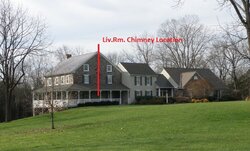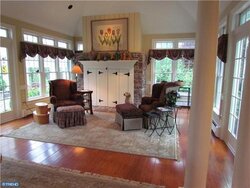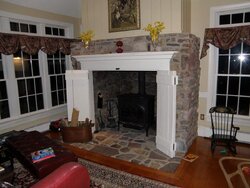We have a Jotul 12 Firelight (predecessor to Jotul 600) in one end of our home, and are now looking for a second stove to heat the other end of the home. The new area to be heated is a 1770's stone farm house with 18" stone exterior walls, and plaster applied directly to the inside of the stone work / no insulation. The stove is to be installed in the firebox of an old cooking fireplace, located in a room of approximately 200 square feet. The stove is intended to heat an interior space of approximately 800 square feet, by providing circulation between the room containing the stove and two adjacent rooms.
The original 1770's firebox dimensions appear to have been 56" wide x 34" deep, but was at some time bricked in to its current firebox dimensions of 48" wide x 26" deep. It may be possible to remove this brickwork, but that will add to the expense and complexity of installation. The fireplace opening is 60" high, common to cooking fireplaces, and strongly favoring a top-loader type stove. I do not believe the 48" wide firebox will make practical any side loader stove.
The hearth has no extension beyond the 26" firebox depth, so I am interested in all options to deal with that. I am not opposed to removing some of the original flooring and building a permanent stone hearth extension, although that may be a challenge considering the existing structure below.
The fireplace currently houses a 40,000 BTU Mendota gas insert, which is overkill for the 200 square foot room in which it is installed, but is completely insufficient for heating the entire 800 square foot space without providing some secondary forced circulation between rooms. I had started another thread to primarily deal with that issue.
Below is the floor plan of the space to be heated by the new stove, along with a photo of the fireplace with the Mendota gas insert installed. We are planning on a complete tear-out of that gas insert and surround / going back to an open firebox with a free standing stove and liner. The 1058 sq.ft. gross dimension listed in the first attachment is including exterior walls, and the 788 sq.ft. is just the net of the three rooms. The actual net (gross minus exterior wall thickness) is roughly 871 sq.ft.
Floor plan:
View attachment 64655
Fireplace as it is today with gas insert:
View attachment 64695
With metal surround removed from gas insert:
View attachment 64696
Please excuse the "early old lady" wallpaper. We just moved in a few months ago / left by previous owner.
We are looking for all recommendations on stoves to check out for this application. We know the most basic pro's and con's of steel vs. cast iron vs. soapstone, and only know the brands Jotul and Hearthstone. This portion of the house is empty except evenings and weekends, and heating with oil, we typically keep the thermostat at 62*F approximately 20 hours per day, heating to 68*F evenings and weekends. We do not mind doing overnight burns, but have never been comfortable loading the stove in the morning and then leaving the house empty all day. For this type of cyclical use, I suspect soapstone is not the way to go, so we're primarily considering cast iron and steel stoves. The house is old (1770's), so cosmetically, we're looking more at cast iron than steel. We have not seen too many high efficiency top-loader stoves in cast iron.
Thank you.
The original 1770's firebox dimensions appear to have been 56" wide x 34" deep, but was at some time bricked in to its current firebox dimensions of 48" wide x 26" deep. It may be possible to remove this brickwork, but that will add to the expense and complexity of installation. The fireplace opening is 60" high, common to cooking fireplaces, and strongly favoring a top-loader type stove. I do not believe the 48" wide firebox will make practical any side loader stove.
The hearth has no extension beyond the 26" firebox depth, so I am interested in all options to deal with that. I am not opposed to removing some of the original flooring and building a permanent stone hearth extension, although that may be a challenge considering the existing structure below.
The fireplace currently houses a 40,000 BTU Mendota gas insert, which is overkill for the 200 square foot room in which it is installed, but is completely insufficient for heating the entire 800 square foot space without providing some secondary forced circulation between rooms. I had started another thread to primarily deal with that issue.
Below is the floor plan of the space to be heated by the new stove, along with a photo of the fireplace with the Mendota gas insert installed. We are planning on a complete tear-out of that gas insert and surround / going back to an open firebox with a free standing stove and liner. The 1058 sq.ft. gross dimension listed in the first attachment is including exterior walls, and the 788 sq.ft. is just the net of the three rooms. The actual net (gross minus exterior wall thickness) is roughly 871 sq.ft.
Floor plan:
View attachment 64655
Fireplace as it is today with gas insert:
View attachment 64695
With metal surround removed from gas insert:
View attachment 64696
Please excuse the "early old lady" wallpaper. We just moved in a few months ago / left by previous owner.
We are looking for all recommendations on stoves to check out for this application. We know the most basic pro's and con's of steel vs. cast iron vs. soapstone, and only know the brands Jotul and Hearthstone. This portion of the house is empty except evenings and weekends, and heating with oil, we typically keep the thermostat at 62*F approximately 20 hours per day, heating to 68*F evenings and weekends. We do not mind doing overnight burns, but have never been comfortable loading the stove in the morning and then leaving the house empty all day. For this type of cyclical use, I suspect soapstone is not the way to go, so we're primarily considering cast iron and steel stoves. The house is old (1770's), so cosmetically, we're looking more at cast iron than steel. We have not seen too many high efficiency top-loader stoves in cast iron.
Thank you.





